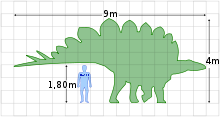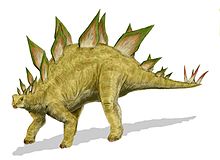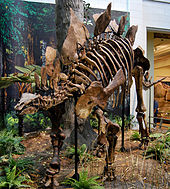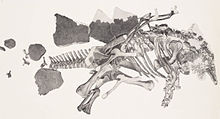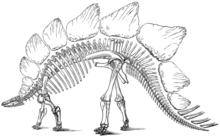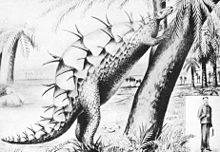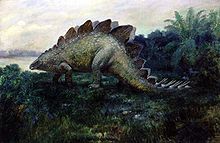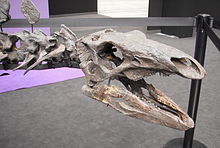
Stegosaurus
Did you know...
The articles in this Schools selection have been arranged by curriculum topic thanks to SOS Children volunteers. SOS Children is the world's largest charity giving orphaned and abandoned children the chance of family life.
| Stegosaurus Temporal range: Late Jurassic, 155–150Ma |
|
|---|---|
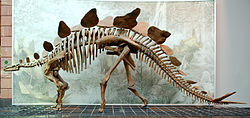 |
|
| Reconstructed S. stenops skeleton, Senckenberg Museum | |
| Scientific classification |
|
| Kingdom: | Animalia |
| Phylum: | Chordata |
| Class: | Reptilia |
| Order: | †Ornithischia |
| Suborder: | †Stegosauria |
| Family: | †Stegosauridae |
| Genus: | †Stegosaurus Marsh, 1877 |
| Type species | |
| †Stegosaurus armatus Marsh, 1877 |
|
| Species | |
|
|
| Synonyms | |
|
|
Stegosaurus (pron.: / ˌ s t ɛ ɡ ɵ ˈ s ɔr ə s /, meaning "roof lizard" or "covered lizard" in reference to its bony plates) is a genus of armored stegosaurid dinosaur. They lived during the Late Jurassic period ( Kimmeridgian to early Tithonian), some 155 to 150 million years ago in what is now western North America. In 2006, a specimen of Stegosaurus was announced from Portugal, showing that they were present in Europe as well. Due to its distinctive tail spikes and plates, Stegosaurus is one of the most recognizable dinosaurs. At least three species have been identified in the upper Morrison Formation and are known from the remains of about 80 individuals.
A large, heavily built, herbivorous quadruped, Stegosaurus had a distinctive and unusual posture, with a heavily rounded back, short forelimbs, head held low to the ground and a stiffened tail held high in the air. Its array of plates and spikes has been the subject of much speculation. The spikes were most likely used for defense, while the plates have also been proposed as a defensive mechanism, as well as having display and thermoregulatory functions. Stegosaurus had a relatively low brain-to-body mass ratio. It had a short neck and small head, meaning it most likely ate low-lying bushes and shrubs. It was the largest of all the stegosaurians (bigger than genera such as Kentrosaurus and Huayangosaurus) and, although roughly bus-sized, it nonetheless shared many anatomical features (including the tail spines and plates) with the other stegosaurian genera.
Description
The quadrupedal Stegosaurus is one of the most easily identifiable dinosaur genera, due to the distinctive double row of kite-shaped plates rising vertically along the rounded back and the two pairs of long spikes extending horizontally near the end of the tail. Although large animals at up to 9 metres (30 ft) in length, the various species of Stegosaurus were dwarfed by their contemporaries, the giant sauropods. Some form of armor appears to have been necessary, as Stegosaurus species coexisted with large predatory theropod dinosaurs, such as Allosaurus and Ceratosaurus.
The hind feet each had three short toes, while each forefoot had five toes; only the inner two toes had a blunt hoof. All four limbs were supported by pads behind the toes. The forelimbs were much shorter than the stocky hindlimbs, which resulted in an unusual posture. The tail appears to have been held well clear of the ground, while the head of Stegosaurus was positioned relatively low down, probably no higher than 1 meter (3.3 ft) above the ground.
The long and narrow skull was small in proportion to the body. It had a small antorbital fenestra, the hole between the nose and eye common to most archosaurs, including modern birds, though lost in extant crocodylians. The skull's low position suggests that Stegosaurus may have been a browser of low-growing vegetation. This interpretation is supported by the absence of front teeth and their replacement by a horny beak or rhamphotheca. Stegosaurian teeth were small, triangular and flat; wear facets show that they did grind their food. The inset placement in the jaws suggests that Stegosaurus had cheeks to keep food in their mouths while they chewed.
Despite the animal's overall size, the braincase of Stegosaurus was small, being no larger than that of a dog. A well-preserved Stegosaurus braincase allowed Othniel Charles Marsh to obtain in the 1880s a cast of the brain cavity or endocast of the animal, which gave an indication of the brain size. The endocast showed that the brain was indeed very small, maybe the smallest among the dinosaurs. The fact that an animal weighing over 4.5 metric tons (5 short tons) could have a brain of no more than 80 grams (2.8 oz) contributed to the popular old idea that all dinosaurs were unintelligent, an idea now largely rejected. Actual brain anatomy in Stegosaurus is poorly known, but the brain itself was however small even for a dinosaur, fitting well with a slow herbivorous lifestyle and limited behavioural complexity.
Most of the information known about Stegosaurus comes from the remains of mature animals; however more recently juvenile remains of Stegosaurus have been found. One sub-adult specimen, discovered in 1994 in Wyoming, is 4.6 meters (15 ft) long and 2 meters (7 ft) high, and is estimated to have weighed 2.3 metric tons (2.6 short tons) while alive. It is on display in the University of Wyoming Geological Museum. Even smaller skeletons, 210 centimeters (6.9 ft) long and 80 centimeters (2.6 ft) tall at the back, are on display at the Denver Museum of Nature & Science.
Classification
Stegosaurus was the first-named genus of the family Stegosauridae. It is the type genus that gives its name to the family. Stegosauridae is one of two families within the infraorder Stegosauria, with the other being Huayangosauridae. Stegosauria lies within the Thyreophora, or armored dinosaurs, a suborder which also includes the more diverse ankylosaurs. The stegosaurs were a clade of animals similar in appearance, posture and shape that mainly differed in their array of spikes and plates. Among the closest relatives to Stegosaurus are Wuerhosaurus from China and Kentrosaurus from east Africa.
Origins
The origin of Stegosaurus is uncertain, as few remains of basal stegosaurs and their ancestors are known. Recently, stegosaurids have been shown to be present in the lower Morrison Formation, existing several million years before the occurrence of Stegosaurus itself, with the discovery of the related Hesperosaurus from the early Kimmeridgian. The earliest stegosaurid (the genus Lexovisaurus) is known from the Oxford Clay Formation of England and France, giving it an age of early to middle Callovian.
The earlier and more basal genus Huayangosaurus from the Middle Jurassic of China (some 165 million years ago) predates Stegosaurus by 20 million years and is the only genus in the family Huayangosauridae. Earlier still is Scelidosaurus, from Early Jurassic England, which lived approximately 190 million years ago. Interestingly, it possessed features of both stegosaurs and ankylosaurs. Emausaurus from Germany was another small quadruped, while Scutellosaurus from Arizona in the USA was an even earlier genus and was facultatively bipedal. These small, lightly armored dinosaurs were closely related to the direct ancestor of both stegosaurs and ankylosaurs. A trackway of a possible early armored dinosaur, from around 195 million years ago, has been found in France.
Discovery and species
Stegosaurus, one of the many dinosaurs first collected and described in the Bone Wars, was originally named by Othniel Charles Marsh in 1877, from remains recovered north of Morrison, Colorado. These first bones became the holotype of Stegosaurus armatus. Marsh initially believed the remains were from an aquatic turtle-like animal, and the basis for its scientific name, 'roof(ed) lizard' was due to his early belief that the plates lay flat over the animal's back, overlapping like the shingles ( tiles) on a roof. A wealth of Stegosaurus material was recovered over the next few years and Marsh published several papers on the genus. Initially, several species were described. However, many of these have since been considered to be invalid or synonymous with existing species, leaving two well-known and one poorly known species. Confirmed Stegosaurus remains have been found in the Morrison Formation's stratigraphic zones 2–6, with additional remains possibly referrable to Stegosaurus recovered from stratigraphic zone 1.
Valid species
- Stegosaurus armatus, meaning "armored roof lizard", was the first species to be found and is known from two partial skeletons, two partial skulls and at least thirty fragmentary individuals. This species had four horizontal tail spikes and relatively small plates. At 9 meters (30 ft), it was the longest species within the genus Stegosaurus. It has been found in the Morrison Formation, Colorado, Wyoming, and Utah, U.S.A.
- Stegosaurus sulcatus, meaning "furrowed roof lizard" was described by Marsh in 1887 based on a partial skeleton. It has traditionally been considered a synonym of S. armatus, though more recent studies suggest it is in fact distinct. A spike associated with the type specimen, originally thought to be a tail spike, may in fact come from the shoulder.
- Stegosaurus longispinus, meaning "long-spined roof lizard", was named by Charles W. Gilmore and known from one partial skeleton, from the Morrison Formation in Wyoming. Stegosaurus longispinus was notable for its set of four unusually long tail spines. Some consider it a species of Kentrosaurus. Like S. stenops, it grew to 7 meters (23 ft) in length. Found in the Morrison Formation, Wyoming and possibly Utah, U.S.A.
- Stegosaurus stenops, meaning "narrow-faced roof lizard", was named by Marsh in 1887, with the holotype having been collected by Marshal Felch at Garden Park, north of Cañon City, Colorado, in 1886. This is the best-known species of Stegosaurus, mainly because its remains include at least one complete articulated skeleton. It had large, broad plates and four tail spikes. Stegosaurus stenops is known from at least 50 partial skeletons of adults and juveniles, one complete skull and four partial skulls. It was shorter than S. armatus, at 7 meters (23 ft). Found in the Morrison Formation, Colorado, Wyoming, and Utah, U.S.A.
Susannah Maidment and colleagues in 2008 proposed extensive alterations to the taxonomy of Stegosaurus. They advocated synonymizing S. stenops and S. ungulatus (sometimes considered valid; see below) with S. armatus, and sinking Hesperosaurus and Wuerhosaurus into Stegosaurus, with their type species becoming Stegosaurus mjosi and Stegosaurus homheni, respectively. They regarded S. longispinus as dubious. Thus, their conception of Stegosaurus would include three valid species (S. armatus, S. homheni, and S. mjosi) and would range from the Late Jurassic of North America and Europe to the Early Cretaceous of Asia. However, this classification scheme has not generally been followed by other researchers. Galton, for example, has stated that Wuerhosaurus differs enough from Stegosaurus to be retained as a distinct genus.
Nomina dubia (dubious names)
- Stegosaurus affinis, described by Marsh in 1881, is only known from a pubis and is considered a nomen dubium. It is possibly synonymous with S. armatus.
- Stegosaurus seeleyanus, originally named Hypsirophus, is probably the same as S. armatus. Stegosaurus (Diracodon) laticeps was described by Marsh in 1881, from some jawbone fragments. Just as some consider S. stenops a species of Diracodon, others consider Diracodon itself to be a species of Stegosaurus. Bakker had resurrected D. laticeps in 1986, although others note that the material is non-diagnostic and likely synonymous with S. stenops.
- Stegosaurus duplex, meaning "two plexus roof lizard" (in allusion to the greatly enlarged neural canal of the sacrum which Marsh characterized as a "posterior brain case"), is probably the same as S. armatus. Although named by Marsh in 1887 (including the holotype specimen), the disarticulated bones were actually collected in 1879 by Edward Ashley at Como Bluff, Wyoming.
- Stegosaurus ungulatus, meaning "hoofed roof lizard", was named by Marsh in 1879, from remains recovered at Como Bluff, Wyoming. It is known from a few vertebrae and armor plates. It might be a juvenile form of S. armatus, although the original material of S. armatus is yet to be fully described. The specimen discovered in Portugal and dating from the upper Kimmeridgian-lower Tithonian stage has been ascribed to this species.
Reassigned species
- Stegosaurus madagascariensis from Madagascar is known solely from teeth and was described by Piveteau in 1926. The teeth were variously attributed to a stegosaur, the theropod Majungasaurus, a hadrosaur or even a crocodylian.
Other remains originally attributed to Stegosaurus are now considered to belong to different genera. This is the case for Stegosaurus marshi, which was described by Lucas in 1901. It was renamed Hoplitosaurus in 1902. Stegosaurus priscus, described by Nopcsa in 1911, was reassigned to Lexovisaurus, and is now the type species of Loricatosaurus.
Paleobiology
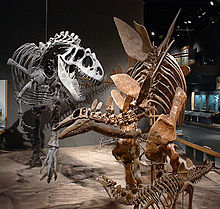
Stegosaurus was the largest stegosaur, possibly weighing up to 5,000 kilograms (5.5 short tons). Soon after its discovery, Marsh considered Stegosaurus to have been bipedal, due to its short forelimbs. He had changed his mind however, by 1891, after considering the heavy build of the animal. Although Stegosaurus is undoubtedly now considered to have been quadrupedal, there has been some discussion over whether it could have reared up on its hind legs, using its tail to form a tripod with its hind limbs and browsing for higher foliage. This has been proposed by Bakker and opposed by Carpenter.
Stegosaurus did have very short forelimbs, in relation to its hind legs. Furthermore, within the hindlimbs, the lower section (comprising the tibia and fibula) was short compared with the femur. This suggests that it couldn't walk very fast, as the stride of the back legs at speed would have overtaken the front legs, giving a maximum speed of 6–7 kilometers per hour (4–5 mi/hr).
Tracks discovered by Matthew Mossbrucker (Morrison Natural History Museum, Colorado) suggest that Stegosaurus lived in multi-age herds. One group of tracks is interpreted as showing four or five baby stegosaurs moving in the same direction, while another has a juvenile stegosaur track with an adult track overprinting it. Stegosaurus may have preferred drier settings than other common Morrison Formation dinosaurs, such as Allosaurus, Apatosaurus, Camarasaurus, and Diplodocus.
Plates
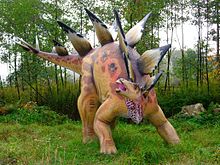
The most recognizable features of Stegosaurus are its dermal plates, which consisted of 17 separate flat plates. These were highly modified osteoderms (bony-cored scales), similar to those seen in crocodiles and many lizards today. They were not directly attached to the animal's skeleton, instead arising from the skin. The largest plates were found over the animal's hips and measured 60 centimeters (2 ft) wide and 60 centimeters tall.
One of the major subjects of books and articles about Stegosaurus is the plate arrangement. The argument has been a major one in the history of dinosaur reconstruction. Four possible plate arrangements have been mooted over the years:
- The plates lie flat along the back, as a shingle-like armor. This was Marsh's initial interpretation, which led to the name 'Roof Lizard'. As further and complete plates were found, their form showed that they stood on edge, rather than lying flat.
- By 1891, Marsh published a more familiar view of Stegosaurus, with a single row of plates. This was dropped fairly early on (apparently because it was poorly understood how the plates were embedded in the skin and it was thought that they would overlap too much in this arrangement). It was revived, in somewhat modified form, in the 1980s, by an artist (Stephen Czerkas), based on the arrangement of iguana dorsal spines.
- The plates paired in a double row along the back. This is probably the most common arrangement in pictures, especially earlier ones (until the ' Dinosaur Renaissance' in the '70s). (The Stegosaurus in the 1933 film, King Kong, has this arrangement.) However, no two plates of identical size and shape have ever been found within the same animal.
- Two rows of alternating plates. By the early 1960s, this had become (and remains) the prevalent idea, mainly because the one Stegosaurus stenops fossil with the plates still articulated indicates this arrangement. An objection to it is that this phenomenon is unknown among other reptiles and it is difficult to understand how such a disparity could evolve.
In the past, some palaeontologists, notably Robert Bakker, have speculated the plates may have been mobile to some degree, although others disagree. Bakker suggested that the plates were the bony cores of pointed horn-covered plates that a Stegosaurus could flip from one side to another in order to present a predator with an array of spikes and blades that would impede it from closing sufficiently to attack the Stegosaurus effectively. The plates would naturally sag to the sides of the Stegosaurus, the length of the plates reflecting the width of the animal at that point along its spine. His reasoning for these plates to be covered in horn is that the surface fossilized plates have a resemblance to the bony cores of horns in other animals known or thought to bear horns, and his reasoning for the plates to be defensive in nature is that the plates had insufficient width for them to stand erect easily in such a manner as to be useful in display without continuous muscular effort.
The function of the plates has been much debated. Initially thought of as some form of armor, they appear to have been too fragile and ill-placed for defensive purposes, leaving the animal's sides unprotected. More recently, researchers have proposed that they may have helped to control the body temperature of the animal, in a similar way to the sails of the large carnivorous Spinosaurus or of the pelycosaur Dimetrodon (and the ears of modern elephants and jackrabbits). The plates had blood vessels running through grooves and air flowing around the plates would have cooled the blood. Recent structural comparisons of Stegosaurus plates to Alligator osteoderms seems to support the conclusion that the potential for a thermoregulatory role in the plates of Stegosaurus definitely exists. This theory has been seriously questioned, since its closest relatives, such as Kentrosaurus, had more low surface area spikes than plates, implying that cooling was not important enough to require specialized structural formations such as plates.
Their large size suggests that the plates may have served to increase the apparent height of the animal, in order either to intimidate enemies or to impress other members of the same species, in some form of sexual display, although both male and female specimens seemed to have had them. It has been suggested that, in addition to looking bigger, Stegosaurus pumped blood into its plates causing them to " blush" which would add to the visual threat display. It is also possible that this blushing could have been used to attract mates. A study published in 2005 supports the idea of their use in identification. Researchers believe this may be the function of other unique anatomical features, found in various dinosaur species. Stegosaurus stenops also had disk-shaped plates on its hips.
Thagomizer (tail spikes)
There has been debate about whether the tail spikes were used for display only, as posited by Gilmore in 1914 or used as a weapon. Robert Bakker noted the tail was likely to have been much more flexible than that of other dinosaurs, as it lacked ossified tendons, thus lending credence to the idea of the tail as a weapon. However, as Carpenter has noted, the plates overlap so many tail vertebrae that movement would be limited. Bakker also observed that Stegosaurus could have maneuvered its rear easily, by keeping its large hindlimbs stationary and pushing off with its very powerfully muscled but short forelimbs, allowing it to swivel deftly to deal with attack. More recently, a study of tail spikes by McWhinney et al., which showed a high incidence of trauma-related damage, lends more weight to the position that the spikes were indeed used in combat. Additional support for this idea was a punctured tail vertebra of Allosaurus into which a tail spike fit perfectly.
Stegosaurus stenops had four dermal spikes, each about 60–90 centimeters (2–3 ft) long. Discoveries of articulated stegosaur armor show that, at least in some species, these spikes protruded horizontally from the tail, not vertically as is often depicted. Initially, Marsh described S. armatus as having eight spikes in its tail, unlike S. stenops. However, recent research re-examined this and concluded this species also had four.
"Second brain"
Soon after describing Stegosaurus, Marsh noted a large canal in the hip region of the spinal cord, which could have accommodated a structure up to 20 times larger than the famously small brain. This has led to the influential idea that dinosaurs like Stegosaurus had a "second brain" in the tail, which may have been responsible for controlling reflexes in the rear portion of the body. It has also been suggested that this "brain" might have given a Stegosaurus a temporary boost when it was under threat from predators. More recently, it has been argued that this space (also found in sauropods) may have been the location of a glycogen body, a structure in living birds whose function is not definitely known but which is postulated to facilitate the supply of glycogen to the animal's nervous system.
Diet
Stegosaurus and related genera were herbivores. However, they adopted a feeding strategy different from that of the other herbivorous ornithischian dinosaurs. The other ornithischians possessed teeth capable of grinding plant material and a jaw structure capable of movements in planes other than simply orthal (i.e. they could chew plants). This contrasts with Stegosaurus (and all stegosaurians), which had small teeth having horizontal wear facets associated with tooth-food contact and a jaw probably capable of only orthal movements.
The stegosaurians were geographically widely distributed in the late Jurassic. Palaeontologists believe it would have eaten plants such as mosses, ferns, horsetails, cycads and conifers or fruits. Grazing on grasses, seen in many modern mammalian herbivores, would not have been possible for Stegosaurus, as grasses did not evolve until late into the Cretaceous Period, long after Stegosaurus had become extinct.
One hypothesized feeding behaviour strategy considers them to be low-level browsers, eating low-growing fruit of various non-flowering plants, as well as foliage. This scenario has Stegosaurus foraging at most one meter above the ground. On the other hand, if Stegosaurus could have raised itself on two legs, as suggested by Bakker, then it could have browsed on vegetation and fruits quite high up, with adults being able to forage up to 6 meters (20 ft) above the ground.
A detailed computer analysis of the biomechanics of Stegosaurus's feeding behaviour was performed in 2010, using two different three-dimensional models of Stegosaurus teeth given realistic physics and properties. Bite force was also calculated using these models and the known skull proportions of the animal as well as simulated tree branches of different size and hardness. The resultant bite forces calculated for Stegosaurus were 140.1 N ( Newton), 183.7 N, and 275 N (for anterior, middle and posterior teeth, respectively), which means that its bite force was less than half that of a Labrador retriever. This indicates that Stegosaurus could have easily bitten through smaller green branches, but would have had difficulty with anything over 12 mm in diameter. Stegosaurus, therefore, probably browsed primarily among smaller twigs and foliage, and would have been unable to handle larger plant parts unless the animal was capable of biting much more efficiently than predicted in this study.
Popular culture
One of the most recognizable of all dinosaurs, Stegosaurus has been depicted on film, in cartoons, comics, as children's toys, and was even declared the State Dinosaur of Colorado in 1982.
